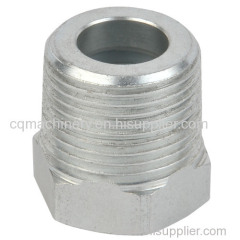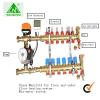The heat sink material is a specific material used fins. Thermal conductivity of each material is different, according to low thermal conductivity are arranged, respectively, silver, copper, aluminum, steel. But if the heat sink with silver to make would be too expensive, so the best solution is the use of copper. Although aluminum is much cheaper, but obviously not as good thermal conductivity of copper is good (only about half a percent point of copper). Common heat sink material is copper and aluminum, both of which have their own advantages and disadvantages. The thermal conductivity of copper is good, but more expensive, higher processing difficulty, excessive weight (a lot more than a copper heatsink CPU restrictions on weight), a small heat capacity, and easily oxidized. The aluminum is too soft and can not be used directly, are used in order to provide sufficient rigidity aluminum, aluminum advantage is low cost, light weight, but the thermal conductivity than copper will be much worse. Some radiators on their respective merits, embedded in a copper aluminum heat sink base. For ordinary users, the use of aluminum cooling fins have been sufficient to meet the needs.
heating radiator nuts

Cooling is the main way the radiators emit heat. In thermodynamics, heat is the heat transfer, and heat transfer, there are three main methods: heat conduction, convection and thermal radiation. When the substance itself or the contact material and the material, the energy transfer is called the thermal conductivity, which is the most common form of heat transfer.
In accordance with the heat away from the radiator way, the heat can be divided into active and passive radiator heat, the former common is air-cooled heat sink, which is a common heat sink. Further subdivided cooling mode, can be divided into air-cooled, heat pipes, liquid cooling, semiconductor refrigeration compressor refrigeration and so on.
heating radiator valve

Aluminum radiator
Aluminum radiator is the most common early radiator, its manufacturing process is simple, low cost, so far, aluminum radiator still holds a considerable part of the market. In order to increase the cooling area of its fins, aluminum radiator is the most common means of processing aluminum extrusion technology, and evaluation of key indicators is an aluminum radiator heat sink base thickness and Pin-Fin ratio. Pin is the height of the heat sink fins, Fin is the distance between the adjacent two fins. Pin-Fin Pin ratio is calculated by dividing the height (excluding base thickness) Fin, Pin-Fin greater the effective radiating area than the larger radiator means, on behalf of the more advanced aluminum extrusion technology.
Ceramic radiator (also known as the ceramic heat exchanger)
Its production process and kiln production process is basically the same, thermal conductivity and oxidation resistance are the main application performance materials. Its principle is to be placed in a ceramic heat sink from the flue outlet close, the temperature is high, no mixed cold and high temperature protection, when the furnace temperature 1250-1450 ℃, the flue outlet temperature should be 1000 -1300 ℃, ceramic heat recovery heat exchanger can reach 450-750 ℃, the recycling of hot air into the furnace and the combustion gas mixture formation, which can reduce production costs and increase economic efficiency.
Use a ceramic heat exchanger in the heat of the limitations of the metal has been very good development because it solves the corrosion resistance, high temperature and other issues, has become a high-temperature waste heat recovery optimum heat exchanger. After years of practice, the results indicate that the ceramic heat exchanger works well. Its main advantages are: thermal performance, high temperature strength, oxidation resistance, good thermal shock resistance, long life, small amount of maintenance, stable and reliable performance, easy operation. Is the best device currently high temperature flue gas waste heat recovery.
Copper radiator
Thermal conductivity of copper is 1.69 times that of aluminum, so in other conditions the same premise, copper radiator can quickly heat away from the heat source. But copper texture is a problem that many advertised "copper radiator" is actually not a true 100% copper. In the list of copper, the copper content of more than 99% of the hormone is called acid copper, copper for the next grade copper content of 85% or less of Dan copper. For most of the copper content of the current copper radiator on the market for 13 years are somewhere in between. Some copper radiators poor copper content of 85% are less even though the cost is low, but the thermal conductivity is greatly reduced, the influence of heat. In addition, copper is also clear [a] significant shortcomings, high costs, processing difficulties, radiator too have hindered the application of quality copper heat sink; copper hardness as good as aluminum AL6063, some mechanical processing (eg cross ditch ) performance as aluminum; copper is much higher than the melting point of aluminum, is not conducive to extrusion (Extrusion) problems.
all kinds heating hardware parts

Copper and aluminum combined with technology
After considering both copper and aluminum materials their disadvantages, some markets high current sink combination of copper and aluminum are often used manufacturing process, the fins are usually made of copper metal base, and the fins are made of aluminum alloy. Of course, in addition to copper base, there are heat sinks with studs and other methods, the principle is the same. With the high thermal conductivity of the bottom surface of copper can quickly absorb the heat released by CPU; aluminum fins can be made by means of a complex process heat is most beneficial shape and provides a large storage space and rapid heat release, which found in all aspects of an equilibrium point.
Radiator common specifications
15*10*20 | Gauge:8 |
15*10*25 | |
15*10*35 |
23*16*25 | Gauge:18 |
23*16*30 | |
23*16*35 | |
23*16*45 |
30*25*25 | Gauge:23 |
30*25*30 |
Our factory:


We can provide for your all kinds of non-standard hardware parts.Please feel free to contact with us and send us the drawing. we will quote the competitive price to you.
Welcome to visit our company.













